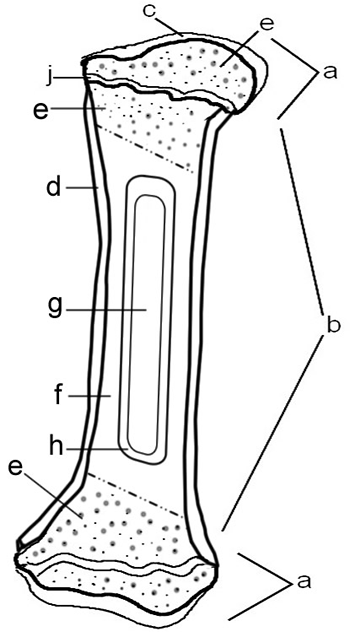Anatomy of a Bone -Coloring

Structures of the Long Bone
The ends of the long bone are called the epiphysis (a), and the shaft of the long bone is called the diaphysis (b). Neither of these areas will be colored.
Within the epiphysis is spongy bone (e), which is also called cancellous bone. The textured appearance of this area is due to the presence of bone marrow. Bone marrow produces new blood cells. Color the spongy bone and marrow on both ends red.
The epiphysis contains a growth plate called the epiphyseal line (j). New bone is created on this plate so the bone can grow longer. Color this line on both ends of the bone purple.
Capping the ends of the epiphysis is the articular cartilage (c) which cushions the ends of the bone. Color the cartilage green.
The periosteum is a fibrous sheath that covers the bone and contains blood vessels and nerves. Color the periosteum (d) dark blue on both sides of the bone. The periosteum is essential for bone growth and repair and has nutrient arteries that supply blood.
Compact bone (f) is a dense bone found in the diaphysis. The compact bone can be seen as the layer just underneath the periosteum, color both sides.
The medullary cavity (g) of the diaphysis serves to reduce bone weight and provide space for yellow marrow, which is made of mostly fat. Color the medullary cavity yellow. Lining the medullary cavity is the endosteum (h). Color the endosteum light blue.
1. Where do you find yellow marrow? __________________________________
2. What is the shaft of the bone called? __________________________________
3. Where do you find red marrow? ________________________________
4. What tissue covers the entire bone? ______________________________
5. Spongy bone is also called _______________________________ bone.
6. What cushions the ends of bones at their joints? ____________________________________
7. What lines the medullary cavity? ______________________________________
8. What produces new blood cells? ___________________________________

